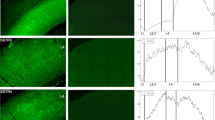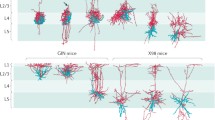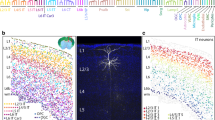Abstract
Somatostatin cells are frequently described as a major population of GABAergic neurons in the cerebral cortex. In this study, we performed a comprehensive analysis of their molecular expression, morphological features, and laminar distribution. We provided a detailed description of somatostatin neurons in the human prefrontal cortex, including their proportion in the total neuron population, laminar distribution, neurotransmitter phenotype, as well as their molecular and morphological characteristics using immunofluorescence and RNAscope in situ hybridization. We found that somatostatin neurons comprise around 7% of neocortical neurons in the human Brodmann areas 9 and 14r, without significant difference between the two regions. Somatostatin cells were NeuN positive and synthesized vesicular GABA transporter and glutamate decarboxylase 1 and 2, confirming their neuronal nature and GABAergic phenotype. Somatostatin cells in the upper cortical layers were small, had a high expression of somatostatin mRNA, a relatively low expression of somatostatin peptide, and co-expressed calbindin. In the lower cortical layers, somatostatin cells were larger with complex somato-dendritic morphology, typically showed a lower expression of somatostatin mRNA and a high expression of somatostatin peptide, and co-expressed neuronal nitric oxide synthase (nNOS) and neuropeptide Y (NPY), but not calbindin. Somatostatin neurons in the white matter co-expressed MAP2. Based on their somato-dendritic morphology, cortical somatostatin neurons could be classified into at least five subtypes. The somatostatin neurons of the human prefrontal cortex show remarkable morphological and molecular complexity, which implies that they have equally complex and distinct functions in the human brain.






Similar content being viewed by others
Data Availability
All data presented in this study are available in the article and accompanying supplementary information. Raw data are available on request from the corresponding author.
References
Scheyltjens I, Arckens L (2016) The current status of somatostatin-interneurons in inhibitory control of brain function and plasticity. Neural Plast 2016:8723623. https://doi.org/10.1155/2016/8723623
Liguz-Lecznar M, Urban-Ciecko J, Kossut M (2016) Somatostatin and somatostatin-containing neurons in shaping neuronal activity and plasticity. Front Neural Circuits 10:48. https://doi.org/10.3389/fncir.2016.00048
Jones EG (1993) GABAergic neurons and their role in cortical plasticity in primates. Cereb Cortex 3:361–372. https://doi.org/10.1093/cercor/3.5.361-a
Silberberg G, Wu C, Markram H (2004) Synaptic dynamics control the timing of neuronal excitation in the activated neocortical microcircuit. J Physiol 556:19–27. https://doi.org/10.1113/jphysiol.2004.060962
Defelipe J, López-Cruz PL, Benavides-Piccione R et al (2013) New insights into the classification and nomenclature of cortical GABAergic interneurons. Nat Rev Neurosci 14:202–216. https://doi.org/10.1038/nrn3444
Urban-Ciecko J, Barth AL (2016) Somatostatin-expressing neurons in cortical networks. Nat Rev Neurosci 17:401–409. https://doi.org/10.1038/nrn.2016.53
Barbas H (2015) General cortical and special prefrontal connections: principles from structure to function. Annu Rev Neurosci 38:269–289. https://doi.org/10.1146/annurev-neuro-071714-033936
Džaja D, Hladnik A, Bičanić I et al (2014) Neocortical calretinin neurons in primates: increase in proportion and microcircuitry structure. Front Neuroanat 8:103. https://doi.org/10.3389/fnana.2014.00103
Hladnik A, Džaja D, Darmopil S et al (2014) Spatio-temporal extension in site of origin for cortical calretinin neurons in primates. Front Neuroanat 8:50. https://doi.org/10.3389/fnana.2014.00050
Song Y-H, Yoon J, Lee S-H (2021) The role of neuropeptide somatostatin in the brain and its application in treating neurological disorders. Exp Mol Med 53:328–338. https://doi.org/10.1038/s12276-021-00580-4
Riedemann T (2019) Diversity and function of somatostatin-expressing interneurons in the cerebral cortex. Int J Mol Sci 20.https://doi.org/10.3390/ijms20122952
Sherwood CC, Raghanti MA, Stimpson CD et al (2010) Inhibitory interneurons of the human prefrontal cortex display conserved evolution of the phenotype and related genes. Proc Biol Sci 277:1011–1020. https://doi.org/10.1098/rspb.2009.1831
Markram H, Toledo-Rodriguez M, Wang Y et al (2004) Interneurons of the neocortical inhibitory system. Nat Rev Neurosci 5:793–807. https://doi.org/10.1038/nrn1519
Ascoli GA, Alonso-Nanclares L, Anderson SA et al (2008) Petilla terminology: nomenclature of features of GABAergic interneurons of the cerebral cortex. Nat Rev Neurosci 9:557–568. https://doi.org/10.1038/nrn2402
Rudy B, Fishell G, Lee S et al (2011) Three groups of interneurons account for nearly 100% of neocortical GABAergic neurons. Dev Neurobiol 71:45–61. https://doi.org/10.1002/dneu.20853
Kawaguchi Y, Kubota Y (1997) GABAergic cell subtypes and their synaptic connections in rat frontal cortex. Cereb Cortex 7:476–486. https://doi.org/10.1093/cercor/7.6.476
Xu X, Roby KD, Callaway EM (2006) Mouse cortical inhibitory neuron type that coexpresses somatostatin and calretinin. J Comp Neurol 499:144–160. https://doi.org/10.1002/cne.21101
Kubota Y, Shigematsu N, Karube F et al (2011) Selective coexpression of multiple chemical markers defines discrete populations of neocortical GABAergic neurons. Cereb Cortex 21:1803–1817. https://doi.org/10.1093/cercor/bhq252
Yavorska I, Wehr M (2016) Somatostatin-expressing inhibitory interneurons in cortical circuits. Front Neural Circuits 10:76. https://doi.org/10.3389/fncir.2016.00076
Tremblay R, Lee S, Rudy B (2016) GABAergic interneurons in the neocortex: from cellular properties to circuits. Neuron 91:260–292. https://doi.org/10.1016/j.neuron.2016.06.033
Wamsley B, Fishell G (2017) Genetic and activity-dependent mechanisms underlying interneuron diversity. Nat Rev Neurosci 18:299–309. https://doi.org/10.1038/nrn.2017.30
Rees CL, White CM, Ascoli GA (2017) Neurochemical markers in the mammalian brain: structure, roles in synaptic communication, and pharmacological relevance. Curr Med Chem 24:3077–3103. https://doi.org/10.2174/0929867324666170414163506
Kubota Y, Hattori R, Yui Y (1994) Three distinct subpopulations of GABAergic neurons in rat frontal agranular cortex. Brain Res 649:159–173. https://doi.org/10.1016/0006-8993(94)91060-x
Kubota Y, Kawaguchi Y (1994) Three classes of GABAergic interneurons in neocortex and neostriatum. Jpn J Physiol 44(Suppl 2):S145–S148
Gonchar Y, Burkhalter A (1997) Three distinct families of GABAergic neurons in rat visual cortex. Cereb Cortex 7:347–358. https://doi.org/10.1093/cercor/7.4.347
Tomioka R, Okamoto K, Furuta T et al (2005) Demonstration of long-range GABAergic connections distributed throughout the mouse neocortex. Eur J Neurosci 21:1587–1600. https://doi.org/10.1111/j.1460-9568.2005.03989.x
Hendry SH, Jones EG, Emson PC (1984) Morphology, distribution, and synaptic relations of somatostatin- and neuropeptide Y-immunoreactive neurons in rat and monkey neocortex. J Neurosci 4:2497–2517. https://doi.org/10.1523/JNEUROSCI.04-10-02497.1984
Lewis DA, Campbell MJ, Morrison JH (1986) An immunohistochemical characterization of somatostatin-28 and somatostatin-281-12 in monkey prefrontal cortex. J Comp Neurol 248:1–18. https://doi.org/10.1002/cne.902480102
Zhu Q, Ke W, He Q et al (2018) Laminar distribution of neurochemically-identified interneurons and cellular co-expression of molecular markers in epileptic human cortex. Neurosci Bull 34:992–1006. https://doi.org/10.1007/s12264-018-0275-x
González-Albo MC, Elston GN, DeFelipe J (2001) The human temporal cortex: characterization of neurons expressing nitric oxide synthase, neuropeptides and calcium-binding proteins, and their glutamate receptor subunit profiles. Cereb Cortex 11:1170–1181. https://doi.org/10.1093/cercor/11.12.1170
Mengod G, Rigo M, Savasta M et al (1992) Regional distribution of neuropeptide somatostatin gene expression in the human brain. Synapse 12:62–74. https://doi.org/10.1002/syn.890120108
Seney ML, Tripp A, McCune S et al (2015) Laminar and cellular analyses of reduced somatostatin gene expression in the subgenual anterior cingulate cortex in major depression. Neurobiol Dis 73:213–219. https://doi.org/10.1016/j.nbd.2014.10.005
Talairach J, Szikla G (1980) Application of stereotactic concepts to the surgery of epilepsy. Acta Neurochir Suppl (Wien) 30:35–54. https://doi.org/10.1007/978-3-7091-8592-6_5
Banovac I, Sedmak D, RojnićKuzman M et al (2020) Axon morphology of rapid Golgi-stained pyramidal neurons in the prefrontal cortex in schizophrenia. Croat Med J 61:354–365. https://doi.org/10.3325/cmj.2020.61.354
Brodmann K (1909) Vergleichende Lokalisationslehre der Grosshirnrinde in ihren Prinzipien dargestellt auf Grund des Zellenbaues. Barth, Leipzig
Ongür D, Price JL (2000) The organization of networks within the orbital and medial prefrontal cortex of rats, monkeys and humans. Cereb Cortex 10:206–219. https://doi.org/10.1093/cercor/10.3.206
Petrides M, Pandya DN (1999) Dorsolateral prefrontal cortex: comparative cytoarchitectonic analysis in the human and the macaque brain and corticocortical connection patterns. Eur J Neurosci 11:1011–1036
Ongür D, Ferry AT, Price JL (2003) Architectonic subdivision of the human orbital and medial prefrontal cortex. J Comp Neurol 460:425–449. https://doi.org/10.1002/cne.10609
Petrides M, Tomaiuolo F, Yeterian EH et al (2012) The prefrontal cortex: comparative architectonic organization in the human and the macaque monkey brains. Cortex 48:46–57. https://doi.org/10.1016/j.cortex.2011.07.002
Sadeghipour A, Babaheidarian P (2019) Making formalin-fixed, paraffin embedded blocks. Methods Mol Biol 1897:253–268. https://doi.org/10.1007/978-1-4939-8935-5_22
Sy J, Ang L-C (2019) Microtomy: cutting formalin-fixed, paraffin-embedded sections. Methods Mol Biol 1897:269–278. https://doi.org/10.1007/978-1-4939-8935-5_23
Zaqout S, Becker L-L, Kaindl AM (2020) Immunofluorescence staining of paraffin sections step by step. Front Neuroanat 14:582218. https://doi.org/10.3389/fnana.2020.582218
Neumann M, Gabel D (2002) Simple method for reduction of autofluorescence in fluorescence microscopy. J Histochem Cytochem 50:437–439. https://doi.org/10.1177/002215540205000315
Sun Y, Ip P, Chakrabartty A (2017) Simple elimination of background fluorescence in formalin-fixed human brain tissue for immunofluorescence microscopy. J Vis Exp. https://doi.org/10.3791/56188
Boenisch T (2005) Effect of heat-induced antigen retrieval following inconsistent formalin fixation. Appl Immunohistochem Mol Morphol 13:283–286. https://doi.org/10.1097/01.0000146524.74402.a4
Banovac I, Sedmak D, Džaja D et al (2019) Somato-dendritic morphology and axon origin site specify von Economo neurons as a subclass of modified pyramidal neurons in the human anterior cingulate cortex. J Anat 235:651–669. https://doi.org/10.1111/joa.13068
Wang F, Flanagan J, Su N et al (2012) RNAscope: a novel in situ RNA analysis platform for formalin-fixed, paraffin-embedded tissues. J Mol Diagn 14:22–29. https://doi.org/10.1016/j.jmoldx.2011.08.002
Wang H, Su N, Wang L-C et al (2014) Quantitative ultrasensitive bright-field RNA in situ hybridization with RNAscope. Methods Mol Biol 1211:201–212. https://doi.org/10.1007/978-1-4939-1459-3_16
Jolly S, Lang V, Koelzer VH et al (2019) Single-cell quantification of mRNA expression in the human brain. Sci Rep 9:12353. https://doi.org/10.1038/s41598-019-48787-w
Banovac I, Sedmak D, Judaš M et al (2021) Von Economo neurons - primate-specific or commonplace in the mammalian brain? Front Neural Circuits 15:714611. https://doi.org/10.3389/fncir.2021.714611
Braak H (1980) Architectonics of the human telencephalic cortex, vol 4. Springer Berlin Heidelberg, Berlin
Sundstrom LE, Brana C, Gatherer M et al (2001) Somatostatin- and neuropeptide Y-synthesizing neurones in the fascia dentata of humans with temporal lobe epilepsy. Brain 124:688–697. https://doi.org/10.1093/brain/124.4.688
Figueredo-CardenaS G, Morello M, Sancesario G et al (1996) Colocalization of somatostatin, neuropeptide Y, neuronal nitric oxide synthase and NADPH-diaphorase in striatal interneurons in rats. Brain Res 735:317–324. https://doi.org/10.1016/0006-8993(96)00801-3
Karagiannis A, Gallopin T, Dávid C et al (2009) Classification of NPY-expressing neocortical interneurons. J Neurosci 29:3642–3659. https://doi.org/10.1523/JNEUROSCI.0058-09.2009
Raghanti MA, Conley T, Sudduth J et al (2013) Neuropeptide Y-immunoreactive neurons in the cerebral cortex of humans and other haplorrhine primates. Am J Primatol 75:415–424. https://doi.org/10.1002/ajp.22082
Tamamaki N, Tomioka R (2010) Long-range GABAergic connections distributed throughout the neocortex and their possible function. Front Neurosci 4:202. https://doi.org/10.3389/fnins.2010.00202
Funding
This research was supported by the Croatian Science Foundation Grants No. IP-2019–04-3182 (Brain extracellular matrix in development and in perinatal hypoxia, PI: Nataša Jovanov Milošević) and No. 5943 (Microcircuitry of higher cognitive functions, PI: Zdravko Petanjek), and co-financed by the Scientific Centre of Excellence for Basic, Clinical, and Translational Neuroscience (project “Experimental and clinical research of hypoxic-ischemic damage in perinatal and adult brain;” GA KK01.1.1.01.0007 funded by the European Union through the European Regional Development Fund).
Author information
Authors and Affiliations
Contributions
Ivan Banovac and Dora Sedmak designed the study. Ivan Banovac acquired the data. All authors analyzed the data, drafted the manuscript, and performed a critical revision of the manuscript.
Corresponding author
Ethics declarations
Ethics Approval
This study was approved by the Ethics Committee of Zagreb University School of Medicine (380–59-10106–14-55/152).
Consent to Participate
Not applicable.
Consent to Publish
Not applicable.
Competing Interests
The authors declare no competing interests.
Additional information
Publisher's Note
Springer Nature remains neutral with regard to jurisdictional claims in published maps and institutional affiliations.
Supplementary Information
Below is the link to the electronic supplementary material.
Rights and permissions
About this article
Cite this article
Banovac, I., Sedmak, D., Esclapez, M. et al. The Distinct Characteristics of Somatostatin Neurons in the Human Brain. Mol Neurobiol 59, 4953–4965 (2022). https://doi.org/10.1007/s12035-022-02892-6
Received:
Accepted:
Published:
Issue Date:
DOI: https://doi.org/10.1007/s12035-022-02892-6




